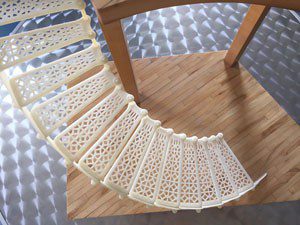FDM 3D Printing (fused deposition modeling) technology builds prototypes, layer by layer. It uses two heated extruding nozzle heads. One nozzle extrudes the main prototype material off a spool. Materials such as ABS, polycarbonates or even wax. A second nozzle extrudes a support material to hold the main material in place. The support material is removed once the build is complete. This process is similar to how a hot glue gun squirts out melted glue but on a much finer, more precise scale. In other words, this process extrudes the material to make a solid part.
The generic terminology for this process is Fused Filament Fabrication (FFF). There are a growing number of companies making 3D printing machines based on the original FDM 3D printing technology that often appeals to the needs of hobbyists and crafters.
FDM 3D Printing Process:
- The STL CAD file is sliced into layers (can vary from .005”/.127 mm – .0010”/.254mm thick layers-dependent on machine capabilities)
- The building platform drops down by one layer of thickness
- With one nozzle the first layer of model is extruded (drawn) onto the platform and simultaneously supports are drawn with the second nozzle
- The part model cross section is filled in with lines of extruded material from the main nozzle
- The process is repeated for subsequent layers, platform dropping as the next layer is applied to the previous layer
- Upon completion, the model is taken from the platform where the supports are removed and is ready for use
The generic terminology for this process is referred to as Fused Filament Fabrication (FFF). There are many companies making 3D printing machines based on the original FDM 3D printing technology. We find this technology appeals to hobbyists and crafters alike.
FDM Printing in Laymen’s Terms:

FDM technology is based on the use of two separately heated nozzle heads (similar to very fine hot glue guns). Using materials such as ABS or polycarbonate , it’s fed off spools and extruded one layer at a time. One nozzle extrudes the main material that the prototype part will be built with (such as ABS). The second nozzle provides a different support material that is removed after. The support material is needed to keep the part material in position as it cools down. For example, if you were to quickly build a 4-sided box with a hot glue gun one layer at a time, the walls would slump and droop if each layer wasn’t fully cooled.
Once the part has fully built and cooled down, the support material is removed leaving your final part ready for use.
As FDM parts and SLS parts are often both white in colour, they can sometimes be confused with each other. However the processes and final parts do have significant differences that could greatly impact your project.
Learn more about the differences on our SLS vs. FDM page.
FDM Advantages:
- Can quickly build one or a few pieces at a time
- More durable than an SLA prototypes due to material options
- Has some functionality due to the nature of ABS material and offers coloured materials
FDM Disadvantages:
- Rough surface finish (you can easily see the extrusion layers and at times, where the supports once existed)
- Only one or a few can be built at a time
- Detail is difficult to capture due to the nature of the process
To learn more about how your prototype can be produced, please visit our 3D printing technologies page or contact us for more information.
In Canada? Be sure to check out the SR&ED program

